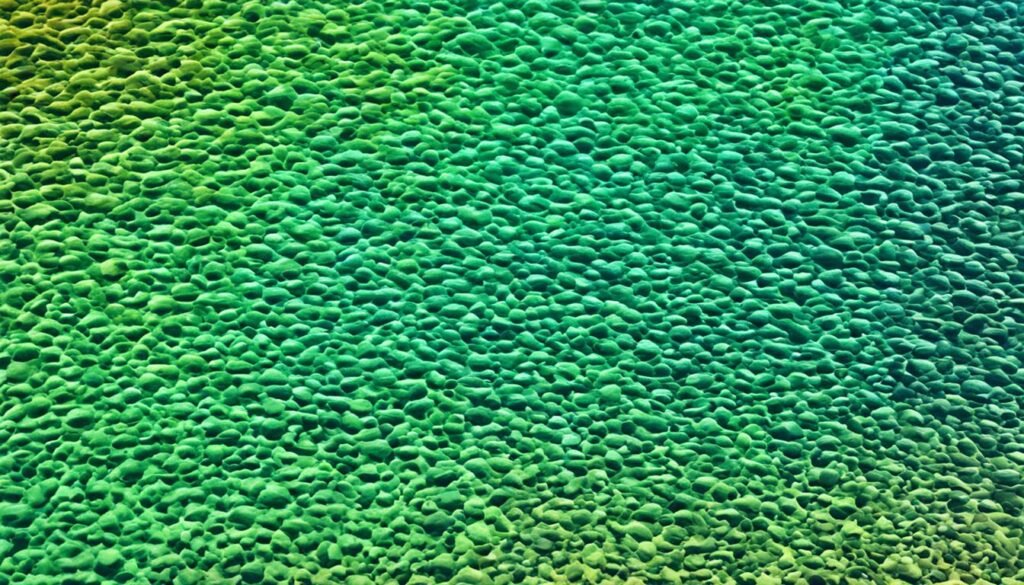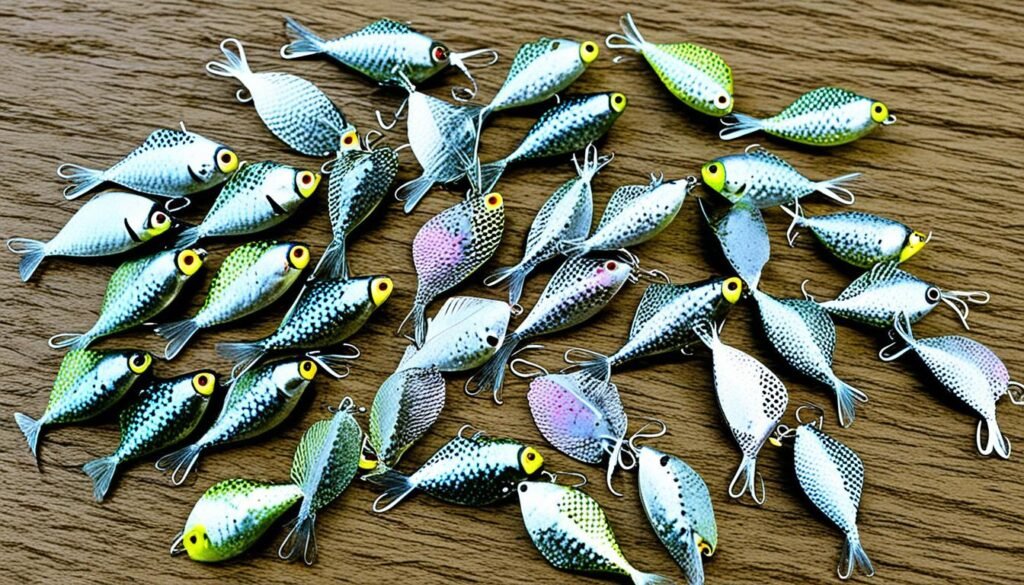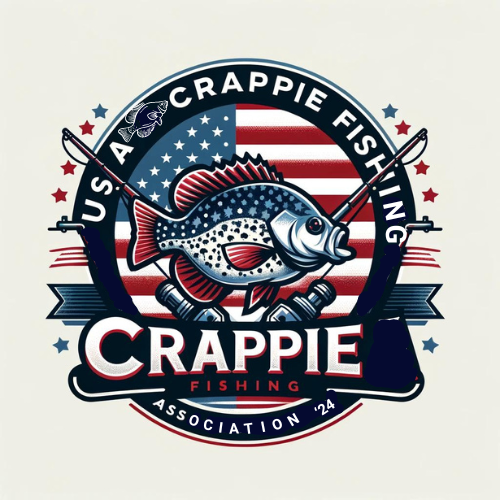As the legendary angler Jimmy Houston once said, “The best lure is the one that gets the job done.” When it comes to crappie fishing, choosing the right lure is crucial for success on the water. With so many options available, from jigs to live bait, it can be challenging to decipher the best choice for enticing these elusive fish.
In this article, I will guide you through the art of lure selection for crappie fishing, taking into consideration factors such as decoding crappie color and bait selection. Whether you’re a seasoned angler looking to refine your technique or a beginner seeking advice, this article will provide you with valuable insights to improve your chances of landing the prized crappie.
Key Takeaways:
- Choosing the right lure is essential for success in crappie fishing.
- Decoding crappie color and understanding fish behavior can help in lure selection.
- Jigs and live bait are popular options for crappie fishing.
- Consider the water clarity and desired bait presentation when selecting a lure.
- Experimentation and adaptation are key to finding the most effective lure for crappie fishing.
Bait Fishing vs. Lure Fishing: What’s the Difference?
When it comes to angling techniques, bait fishing and lure fishing are two distinct approaches that every angler should be familiar with. While both methods aim to attract fish, they rely on different strategies and tools. Let’s explore the contrasting characteristics of bait fishing and lure fishing, along with their unique advantages and considerations.
Bait Fishing
Bait fishing involves using natural bait, such as worms, minnows, or insects, to entice fish. This technique capitalizes on the inherent attraction of real food sources for fish, mimicking their natural feeding habits. By presenting live or dead bait to the fish, anglers aim to trigger their feeding response and secure a successful catch.
- Natural Bait: Bait fishing relies on the use of natural food sources, making it an authentic and familiar choice for fish.
- Appealing to Target Species: The use of live bait can specifically target certain species that are naturally attracted to the scent and movement of live prey.
- Beginner-Friendly: Bait fishing is relatively easy to learn, making it a suitable option for beginners or anglers who prefer a more relaxed fishing experience.
In bait fishing, the key is to present the bait naturally, allowing fish to approach and consume it without suspicion.
Lure Fishing
Lure fishing, on the other hand, revolves around using artificial lures to imitate the movements and behavior of natural prey. Lures are typically made of various materials, including plastic, metal, or wood, and are designed to replicate the appearance, color, and action of baitfish, insects, or other aquatic creatures. Anglers manipulate the lure to mimic the natural movements of prey and entice fish into striking.
- Artificial Lures: Lure fishing relies on the use of creatively crafted artificial lures, offering a wide range of designs, colors, and sizes to suit different fishing conditions and target species.
- Versatility: Using lures allows anglers to experiment with different techniques, such as topwater, crankbait, or jigging, to attract fish in diverse environments.
- Precision and Control: Anglers have greater control over lure fishing, allowing them to present the lure accurately and manipulate its action to trigger a strike.
Lure fishing relies on the angler’s ability to mimic the movement, appearance, and behavior of natural prey, fooling the fish into thinking it is a genuine opportunity for a meal.
Bait Fishing vs. Lure Fishing: Making the Choice
When deciding whether to use bait fishing or lure fishing, several factors should be taken into consideration. The choice between the two techniques depends on the specific fishing scenario, target species, angler’s skill level, and personal preferences. Some anglers prefer the simplicity and natural appeal of bait fishing, while others enjoy the versatility and control offered by lures.
Ultimately, both bait fishing and lure fishing have their merits, and successful anglers often employ a combination of these techniques to adapt to various fishing conditions and increase their chances of catching their desired fish.
Pros and Cons of Bait Fishing
Bait fishing is a popular angling technique that utilizes natural bait to entice fish. It offers several advantages and considerations that anglers should keep in mind when deciding on their fishing approach. Let’s explore the pros and cons of bait fishing:
Pros of Bait Fishing
- Effective and Natural Bait: Bait fishing allows anglers to use natural and highly effective bait that can attract a variety of fish species. Natural bait, such as live minnows, worms, or crickets, can mimic the fish’s natural prey and increase the chances of a successful catch.
- Easy to Use: Bait fishing is relatively straightforward and doesn’t require extensive technical knowledge or advanced fishing skills. It is a great option for beginners or anglers who prefer a more relaxed and hassle-free fishing experience.
Cons of Bait Fishing
- Constant Bait Replenishment: One major downside of bait fishing is the need for constant bait replenishment. Live bait can perish quickly, and anglers may need to periodically check and replace their bait throughout the fishing session to maintain its effectiveness.
- Potential for Unwanted or Smaller Fish: While bait fishing can attract the target species, it can also attract unwanted or smaller fish. If you’re specifically targeting larger fish, using bait may lead to more interactions with undesirable catches.
Despite the cons, bait fishing remains a popular choice among anglers who value the authenticity and effectiveness of natural bait. It offers simplicity and can be a rewarding technique for those new to fishing or seeking a more traditional approach.

Pros and Cons of Lure Fishing
Lure fishing is a popular angling technique that offers its own set of advantages and considerations. Let’s explore the pros and cons of lure fishing:
Pros of Lure Fishing
- Reusable and versatile bait: Lures can be used multiple times, saving the angler money on constantly purchasing live bait.
- Fewer unwanted catches: With lures, anglers have more control over the type and size of fish they target, reducing the likelihood of catching unwanted or undersized fish.
- Higher chance of hooking trophy fish: Lures are designed to mimic the movement and appearance of natural prey, increasing the likelihood of attracting larger, trophy-sized fish.
- Great for catch and release: Lures are often equipped with barbless hooks, making catch and release easier and more humane.
Cons of Lure Fishing
- Requires skill and practice: Lure fishing requires more technique and finesse compared to bait fishing. It takes time and practice to master the proper presentation and retrieve.
- May not be as effective as bait fishing: While lures can be highly effective, there are instances when fish may be more enticed by natural baits. It’s essential to understand the fish’s behavior and environmental factors to determine the best approach.
- Can be more costly: Investing in a variety of lures to cater to different fishing conditions and species can be more expensive compared to purchasing live bait.
“Lure fishing offers anglers the thrill of using artificial bait to outsmart fish and increases the likelihood of hooking trophy-sized catches.”
Overall, lure fishing provides anglers with the advantage of reusable bait, control over their catches, and the potential to hook trophy fish. However, it requires skill, practice, and careful consideration of fishing conditions. Now let’s move on to the next section to explore tips for choosing the right lure for crappie fishing.
Choosing the Right Lure for Crappie Fishing
When it comes to crappie fishing, selecting the right lure can make all the difference in your success on the water. To increase your chances of landing that prize-worthy crappie, it is essential to consider various factors such as water clarity, fish behavior, and desired bait presentation.
One crucial aspect to keep in mind is to choose a lure that mimics the natural prey of the crappie. This will entice them to strike and increase your chances of a successful catch. Whether you opt for live bait or artificial lures, understanding the preferences of crappie and the fishing environment is key.
To help you make an informed decision, here are some factors to consider when selecting the perfect lure for crappie fishing:
Fish Behavior: Understanding the Target Species
Before heading out to the water, it is crucial to familiarize yourself with the feeding habits and behavior of crappie. Crappie are known to feed on a variety of prey depending on the season and location, such as small minnows, insects, and crustaceans. By understanding their natural feeding patterns, you can choose a lure that closely resembles their preferred prey.
Water Clarity: Adapting to the Environment
The clarity of the water plays a significant role in determining the visibility of your lure. In clear water, opting for lures that imitate natural colors and have subtle presentations tends to be more effective in enticing crappie to bite. On the other hand, in murky or stained water, lures with bright colors, wide wobbles, and loud rattles may be more visible and attractive to crappie.
Bait Presentation: Matching the Hatch
When it comes to bait presentation, it is important to consider the depth at which crappie are feeding and the preferred fishing technique. By adjusting the weight, size, and retrieval speed of your lure, you can mimic the movement and behavior of the natural prey, increasing your chances of a successful strike.
| Lure Type | Best Fishing Techniques |
|---|---|
| Jigs | Vertical jigging, casting, spider rigging |
| Soft plastics | Slow trolling, casting, jigging |
| Spinnerbaits | Retrieving, slow trolling |
| Crankbaits | Trolling, casting |
Remember, the success of your crappie fishing adventure depends on selecting the right lure that appeals to their natural instincts and is suitable for the fishing environment. By considering factors such as water clarity, fish behavior, and desired bait presentation, you can significantly increase your chances of a memorable and fruitful fishing trip.

Lure Selection for Different Water Clarities
When it comes to selecting lures for crappie fishing, water clarity plays a crucial role. The visibility of the water can determine the effectiveness of different lure types and presentations. Let’s explore the best lure selection strategies for clear and murky water conditions.
Lure Selection in Clear Water
In clear water, crappie have excellent visibility, making it important to choose lures that closely imitate the actual forage species they are feeding on. Natural colors and subtle presentations work best in clear water conditions. Opt for lures that closely mimic the appearance and movement of small baitfish such as minnows or shad.
A classic choice for clear water is a small jig or soft plastic bait with natural colors such as silver, white, or olive. These colors blend well with the surroundings and provide a realistic presentation for crappie. Remember, in clear water, less is often more when it comes to lure selection.
Additionally, consider using lures with a slow and subtle retrieve to mimic the natural movements of prey. Avoid excessive noise or flashy features, as crappie in clear water can be easily spooked by unnatural presentations.
Lure Selection in Murky Water
Unlike clear water, murky water reduces visibility and makes it more challenging for crappie to locate their prey. In these conditions, it is crucial to choose lures that stand out and create strong sensory signals to attract crappie. Lures with bright colors, wide wobbles, and loud rattles are more effective in murky water.
Brightly colored lures ranging from chartreuse to pink or even fluorescent hues can create a strong contrast against the murky background, making it easier for crappie to spot and strike. These vibrant colors help capture the attention of crappie and trigger their predatory instincts.
When selecting lures for murky water, opt for those with a more aggressive action. Lures that generate strong vibrations and rattling sounds can attract crappie from a greater distance, compensating for the reduced visibility.
Here’s a quick comparison between lure selection strategies for clear and murky water:
| Lure Selection | Clear Water | Murky Water |
|---|---|---|
| Water Clarity | Clear | Murky |
| Color Preference | Natural Colors | Bright Colors |
| Bait Imitation | Small Baitfish | Strong Sensory Signals |
| Retrieval Style | Slow and Subtle | Aggressive |
By understanding how water clarity affects crappie behavior and utilizing appropriate lure selection strategies, anglers can significantly increase their success when targeting crappie in different water conditions.

The Role of Sinkers in Crappie Rigs
Sinkers play a crucial role in crappie fishing rigs by aiding in proper bait presentation. These weights, also known as fishing sinkers, are attached to the fishing line and have a significant impact on how the bait or lure is presented to the fish. By understanding the different types of sinkers and their applications, anglers can maximize their chances of success in catching crappie.
When selecting a sinker for a crappie rig, it is essential to consider the size and shape of the weight. The weight’s size determines the rate at which the bait sinks, while the shape affects its movement in the water. A heavier sinker will make the bait sink faster, allowing it to reach the desired depth quickly.
There are various types of sinkers used in crappie fishing, each designed for specific techniques. Trolling sinkers, for example, are ideal for pulling baits through the water at varying speeds. Slipbobber sinkers are used for creating a slip rig setup, where the bait can move freely in the water column. Spider rigging sinkers, on the other hand, are commonly used in multi-rod fishing setups to cover a larger area.
The Different Types of Sinkers Used in Crappie Fishing Rigs:
- Trolling sinkers: These sinkers are designed to reduce line visibility and allow baits to travel at varying depths and speeds.
- Slipbobber sinkers: These sinkers are perfect for slip rig setups and allow the bait to move freely in the water column.
- Spider rigging sinkers: These sinkers are used in multi-rod fishing setups to cover more water and increase the chances of catching crappie.
Choosing the right sinker for your crappie rig depends on the specific fishing technique you’re using and the conditions you’re fishing in. Experimentation and experience are key to finding the perfect sinker that helps you present your bait effectively and entice crappie to bite.

Image: Crappie Rigs – Sinkers play a crucial role in crappie fishing rigs.
Types of Sinkers Used by Crappie Pros
As seasoned anglers, crappie pros understand the importance of choosing the right sinkers to enhance their bait presentation. They continuously experiment with different styles and sizes of sinkers to maximize their chances of landing a successful catch. Here are some popular sinker types used by crappie pros:
1. Mr. Crappie Weights
Mr. Crappie weights are specially designed sinkers that offer excellent sensitivity and precision. They come in various sizes and shapes, including teardrop and bell-shaped weights. These sinkers allow crappie pros to feel even the slightest nibble, giving them a competitive edge when targeting these elusive fish.
2. Egg Sinkers
Egg sinkers are versatile sinkers that crappie pros often rely on. These cylindrical-shaped sinkers have a hole running through the center, allowing the line to freely move. Egg sinkers are an excellent choice for various fishing techniques, such as bottom fishing or slip sinking rigs.
3. Bullet Sinkers
Bullet sinkers are streamlined sinkers with a pointed tip, resembling a bullet. These sinkers offer excellent casting distance and minimize snagging, making them a favorite among crappie pros who fish in dense cover or brushy areas. They are particularly effective for techniques like trolling and slipbobber fishing.
4. Magnum Split Shot
Magnum split shot sinkers are small, round sinkers with a split in the middle. They are effective for fine-tuning the depth and presentation of the bait, allowing crappie pros to make precise adjustments on the go. These sinkers are popular when targeting crappie in shallow waters or when finesse fishing is required.
Each type of sinker offers its unique advantages and considerations, and crappie pros carefully select the appropriate sinker based on factors such as water conditions, target fish behavior, and fishing technique. By leveraging their experience and knowledge, these professionals optimize their bait presentation and increase their chances of a successful crappie catch.
Sinkers for Different Crappie Techniques
When it comes to crappie fishing, utilizing the right sinker for each technique can make all the difference. Different techniques require specific types of sinkers to achieve optimal results. Let’s explore some common crappie fishing techniques and the sinkers that work best for each:
Trolling and Spider Rigging
Trolling and spider rigging are popular techniques for covering a large area and locating active crappie. For these techniques, bell-shaped sinkers are highly effective. The bell shape allows the sinker to move smoothly through the water, reducing line twist and creating a natural presentation that entices crappie to bite. The weight of the sinker can be adjusted to control the depth at which the bait or lure is presented.
Slipbobber Setups
A slipbobber setup is a versatile technique that allows anglers to suspend their bait or lure at a specific depth. When using slipbobber setups for crappie fishing, egg sinkers are a popular choice. The cylindrical shape and central hole of egg sinkers allow the line to pass through freely, enabling easy adjustment of the desired fishing depth. In addition, the weight of the sinker helps to keep the bait suspended at the desired level.
Trolling and Slipbobber Techniques in Brushy Areas
When crappie fishing in brushy areas, such as submerged trees or vegetation, bullet sinkers are often preferred. The streamlined shape of bullet sinkers helps reduce snagging in dense cover. These sinkers are also effective for trolling and slipbobber techniques as they allow the bait or lure to glide smoothly through underwater obstacles, increasing the chances of enticing crappie to strike.
Understanding the specific techniques used in crappie fishing and selecting the appropriate sinkers for each technique can greatly enhance your success on the water. Whether you’re trolling, spider rigging, using slipbobber setups, or targeting crappie in brushy areas, the right sinker can make a significant difference in your ability to attract and hook these prized fish.
| Crappie Fishing Technique | Recommended Sinker Type |
|---|---|
| Trolling and Spider Rigging | Bell-shaped sinkers |
| Slipbobber Setups | Egg sinkers |
| Trolling and Slipbobber Techniques in Brushy Areas | Bullet sinkers |
Tips for Choosing the Right Sinkers
When it comes to crappie fishing, the choice of sinkers can significantly impact your success on the water. Selecting the right sinker involves considering various factors such as water conditions, fishing depth, and the target fish species. Here are some essential tips to guide you in choosing the perfect sinkers for your crappie fishing adventures.
Fish Species and Fishing Depth
The type of fish you are targeting and the depth at which they are feeding directly influence your sinker selection. For crappie, which are typically found in shallower waters, lighter sinkers are usually sufficient to get your bait to the desired depth. However, if you are targeting larger crappie or fishing in deeper waters, using heavier sinkers might be necessary to ensure proper bait presentation.
Water Conditions
The clarity and current of the water also play a role in sinker selection. In clear water, where fish can easily spot your bait, using a lighter and more discreet sinker can help prevent spooking the crappie. On the other hand, in murkier or faster-flowing waters, opting for slightly heavier and more prominent sinkers can enhance visibility and attract the attention of nearby crappie.
Bait Presentation and Line Breakage
The weight, shape, and design of the sinker should be chosen to ensure proper bait presentation and minimize snags or line breakage. A well-balanced sinker will help your bait float naturally and mimic the movements of live prey, increasing its effectiveness in enticing crappie. Additionally, selecting sinkers with streamlined shapes can reduce the risk of snagging on underwater structures, improving your chances of landing a successful catch.
Sinker Options
When it comes to sinkers, you have a variety of options to choose from. Some popular sinker types used by experienced crappie anglers include:
- Split Shot Sinkers: These small, versatile sinkers are easy to adjust on your line, allowing you to fine-tune your bait presentation.
- Slip Sinkers: These sinkers slide freely on the line, allowing for natural bait movement and reducing resistance when crappie take the bait.
- Bell Sinkers: Bell-shaped sinkers are often used for trolling and spider rigging techniques, providing stability and minimizing line twist.
- Egg Sinkers: Ideal for slipbobber setups, egg sinkers are designed to slide and allow for highly sensitive and responsive bait presentations.
Experimenting with different sinker types and weights can help you determine the most effective combination for your specific crappie fishing techniques and conditions.
| Sinker Type | Best Use |
|---|---|
| Split Shot Sinkers | Adjustable and versatile |
| Slip Sinkers | Natural bait movement |
| Bell Sinkers | Trolling and spider rigging |
| Egg Sinkers | Slipbobber setups |
Remember, choosing the right sinkers for crappie fishing requires careful consideration of the fishing conditions and your desired bait presentation. By following these tips and experimenting with different sinker options, you can optimize your chances of success on your next crappie fishing trip.
Conclusion
After exploring the art of crappie fishing, it’s clear that choosing the right lure is essential for success. Factors such as water clarity, fish behavior, and bait presentation should be carefully considered. By selecting a lure that mimics the natural prey of crappie and is suitable for the fishing environment, anglers can greatly increase their chances of a successful catch.
In addition to lure selection, the role of sinkers in crappie rigs should not be overlooked. Sinkers play a crucial role in making proper presentations, affecting the way the bait or lure is presented to the fish. By understanding the different types of sinkers and their advantages, anglers can enhance their bait presentation and maximize their fishing experience.
By incorporating these factors and tips into their crappie fishing strategy, anglers can increase their success in any situation. Whether you’re a beginner or a seasoned pro, understanding the importance of lure selection and the role of sinkers will undoubtedly improve your fishing game. So, get out there, experiment with different lures and sinkers, and enjoy the excitement of crappie fishing!
